How Many Companies Use AI in 2025? Latest Adoption Stats & Trends

David Pawlan
Co-Founder

Share to AI
Ask AI to summarize and analyze this article. Click any AI platform below to open with a pre-filled prompt.
As the one leading AI adoption at your company, you’re carrying a lot. Expectations from leadership. Pressure to show results. A team waiting on your next move. And with so much hype around artificial intelligence, it’s hard to tell who’s actually doing what and whether you’re ahead, behind, or somewhere in between.
That’s why we built this guide. You’ll get a clear view of how many companies use AI in 2025, where adoption is happening fastest, and how it breaks down across industries and regions. You’ll also see which strategies are gaining traction and what risks to avoid. At Aloa, we help mid-sized and enterprise teams streamline business operations with custom AI systems, from internal tools to ERP integrations, with a focus on real outcomes, not just hype.
Next, we’ll walk through the numbers. You’ll see where AI adoption is trending, where companies are investing, and how others are adjusting their systems to capture real value, so you can benchmark your own roadmap with clarity.
The Current Landscape of AI Adoption in 2025
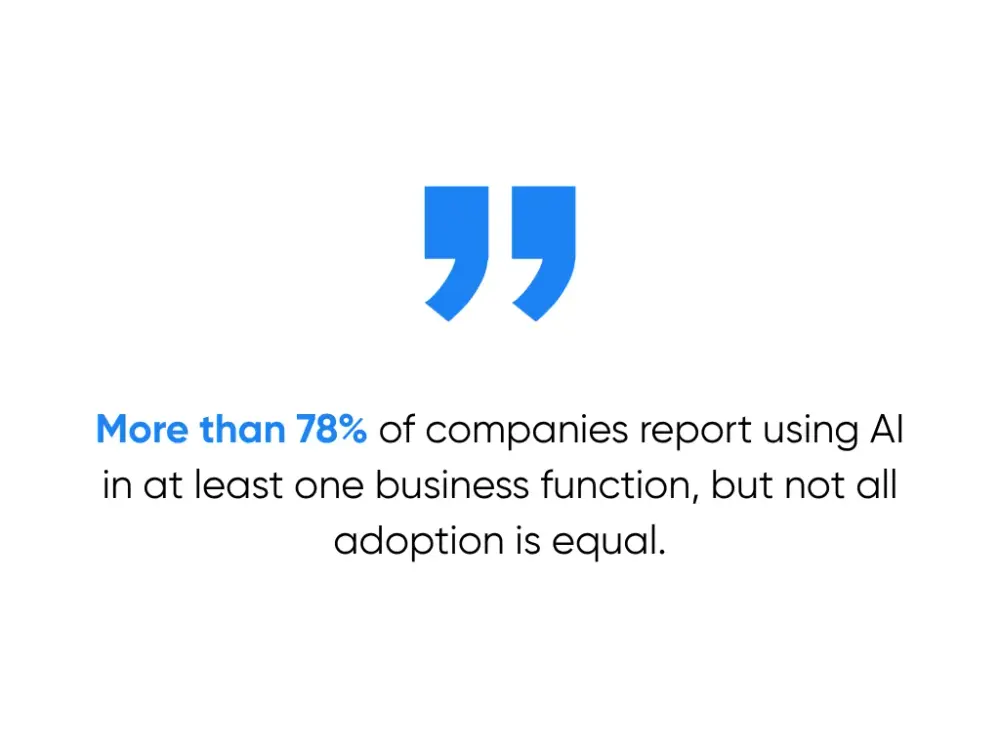
AI might be everywhere in headlines, but it’s still figuring out its place in everyday life at work. When it comes to how many companies use AI, the latest data shows more than 78% report using it in at least one business function. The reality, though, is that not all adoption of AI is equal. Some teams are scaling real systems. Others are stuck running disconnected pilots that never make it past testing.
Here’s what AI applications look like when they’re past the pilot stage:
- Finance: At JPMorgan, AI reviews thousands of legal contracts in seconds, which is something that used to take lawyers weeks. Capital One also uses machine learning to flag fraud in real time, without blocking legitimate customer activity.
- Retail: Walmart uses AI to predict inventory needs down to the store and season to cut down on overstock and stockouts. Amazon’s recommendation engine isn’t just about suggestions, too. It drives a major chunk of their revenue.
- Healthcare: The Mayo Clinic even uses AI to help radiologists catch anomalies faster and with greater accuracy. Pfizer also runs simulations with machine learning to speed up drug discovery and reduce trial failures.
- Supply Chain: FedEx routes packages using real-time AI models that factor in weather, traffic, and urgency. DHL’s warehouses run on computer vision to monitor inventory movement and reduce errors.
Here are the different kinds of tools most teams are leaning on right now:
- Natural language processing (NLP) for support tickets, internal reports, and document tagging
- Forecasting models for pricing, demand planning, and customer scoring
- Computer vision for quality checks and monitoring in production lines
- Chatbots and AI agents for both customer service and internal operations
- Generative AI to help teams create content, automate docs, or build out product briefs
The difference we’re seeing isn’t just in tool usage, but also in mindset. The teams that are getting real value from AI technology treat it like part of their infrastructure, not just another initiative. They’re thinking long-term, aligning leadership, and building internal systems that scale.
How Organizations Are Rewiring to Capture AI Value
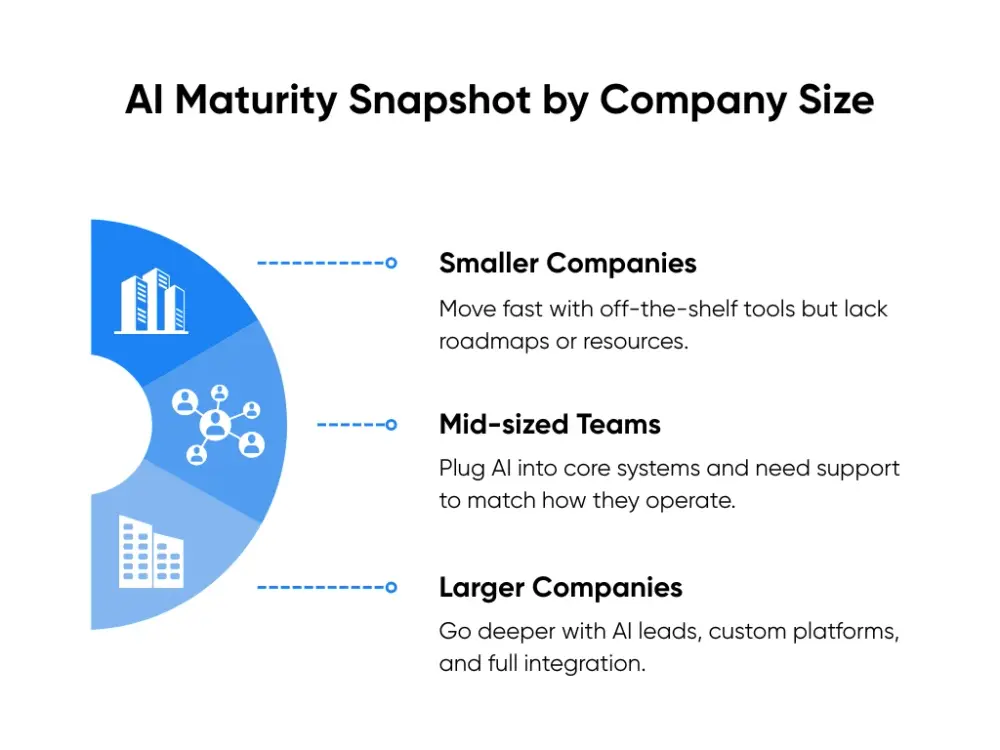
AI adoption starts with structure. In other words, your org’s setup (tech stack, processes, leadership alignment) impacts how far you can take AI.
What we’re seeing across the board is that company size and structure shape the pace and scale of adoption:
- Smaller companies tend to move fast with off-the-shelf AI tools, such as chatbots for customer support or automated analytics dashboards. These teams usually run lean, so they’re experimenting, testing quickly, and layering AI into very specific use cases. What’s often missing is a broader roadmap or the in-house resources to go further.
- Mid-sized teams are where things start to shift. These companies are building internal tools, plugging AI into core systems, and looking for ways to reduce manual workflows without overhauling everything at once. We work with a lot of teams in this space who want to move quickly but need support designing solutions that match how they operate, not just whatever’s trending.
- Larger companies are going deeper. They're reorganizing around AI initiatives, hiring dedicated AI leads, and investing in long-term infrastructure. Think custom platforms, internal models, full integration across departments. These orgs usually have more data, more layers of approval, and more pressure to show cross-functional ROI.
The teams making AI work aren’t the ones with the biggest budgets. They have executives who prioritize AI at the strategy level, not just as an IT project. They also create space for experimentation, allocate real resources, and keep their AI goals tied directly to business outcomes.
That’s where Aloa’s approach often fits best: we help teams prototype early, pressure-test ideas before scaling, and work closely with both technical and non-technical stakeholders to build something that lasts.
Regional Variations in AI Adoption
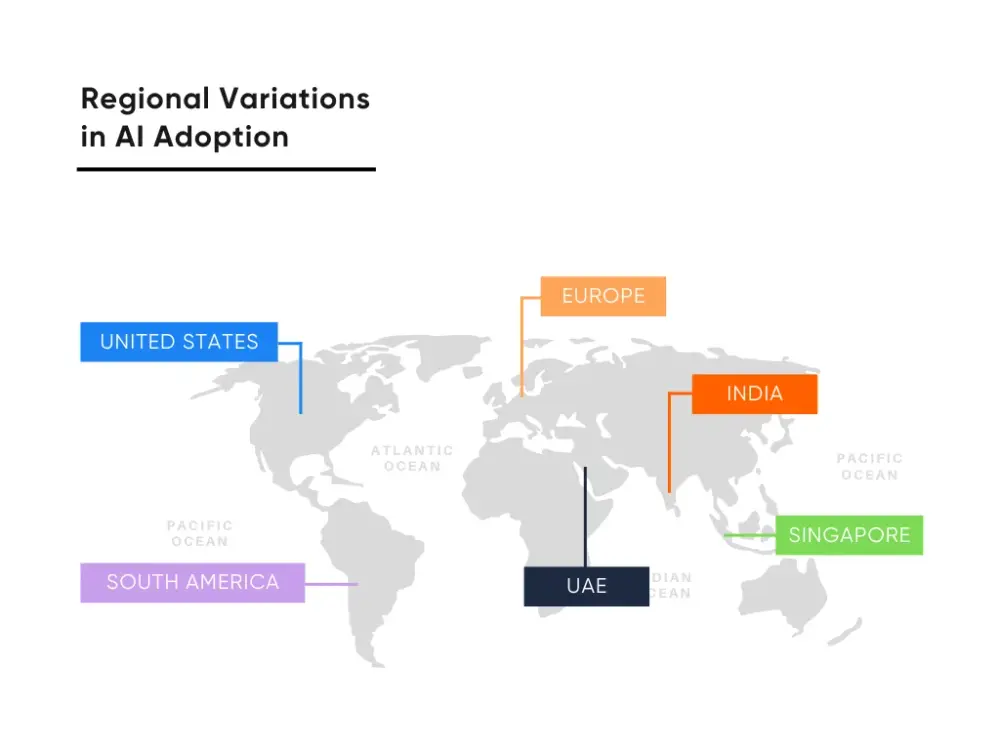
When you’re managing AI rollouts across different markets, the challenges shift. Same goals, same tools, but success hinges on what each region is ready for. Infrastructure, policy, and organizational appetite all play a part.
Here’s where we’re seeing clear patterns:
United States
Adoption is happening, especially in sectors that already have clean, structured data. Banks are catching fraud in real time before it hits your customers. Hospitals are using testing tools to flag high-risk patients using intake forms. Logistics teams are replanning delivery routes on the fly based on traffic and weather. Small implementations are making a huge difference.
In areas like construction and hardware engineering, progress is less obvious. These teams are working with older systems and lower AI budgets. Instead of building out platforms, they’re stitching together point solutions for scheduling, cost tracking, or inspections. This is a sign that interest is there, even if the infrastructure isn’t yet.
Europe
In contrast with the US, where speed to market often takes priority, Europe has strict requirements around privacy, transparency, and explainability reviews. These requirements are shaped by regulations like the GDPR and the upcoming AI Act.
For example, if a bank wants to launch a customer-facing chatbot, it has to prove not only that the bot works, but also that customers understand how their data is used, that bias has been tested for, and that every decision the bot makes can be explained in plain language.
These rules can slow down AI rollouts, but they haven’t stopped progress altogether. In Germany and the Netherlands, AI is being used for predictive maintenance, robotic inspection, and real-time quality checks in manufacturing. Energy firms are using forecasting models to stabilize demand across grids. It’s steady progress, just more measured than in markets with fewer regulatory steps.
South America
In Brazil, farmers are flying drone fleets over vast soybean fields to capture high-resolution imagery, then running those images through ML models to fine-tune irrigation schedules and predict yields weeks in advance. In Chile and Colombia, city planners are piloting AI-powered traffic control systems that adjust light patterns in real time, which cuts congestion on busy commuter routes during rush hour.
South America is also a rising hub for AI and software development talent, particularly for companies in North America looking to outsource. Cities like São Paulo, Buenos Aires, and Medellín are home to engineering teams that can design, train, and deploy AI tools at a fraction of the US cost. A mid-sized retailer, for example, might partner with a Colombian dev shop to build a custom recommendation engine in months rather than a year, avoiding steep salaries and hiring bottlenecks in their home market.
These projects tend to be sharply focused rather than sprawling platform builds. The combination of clear ROI, targeted scope, and accessible talent makes them easier to fund, approve, and deliver, with benefits showing up fast enough to keep leadership on board.
India, Singapore, and the UAE
In India, internal AI tools for finance, logistics, and operations are getting off the ground quickly, often backed by government grants or university partnerships. Singapore’s hospitals are testing triage models that help staff prioritize patients more efficiently. The UAE is also using predictive analytics across energy, transport, and security to boost efficiency system-wide.
When everyone’s rowing in the same direction (leadership, infrastructure, policy), it clears the path for momentum.
If you’re responsible for coordinating across regions, these variations will help you figure out where to launch fast, where to tread carefully, and where to wait until conditions are right.
That’s exactly the kind of context we build for at Aloa. We don’t just engineer AI systems. We help teams account for regional complexity, industry variation, and operational constraints from day one.
The Impact of AI on Workforce and Skills
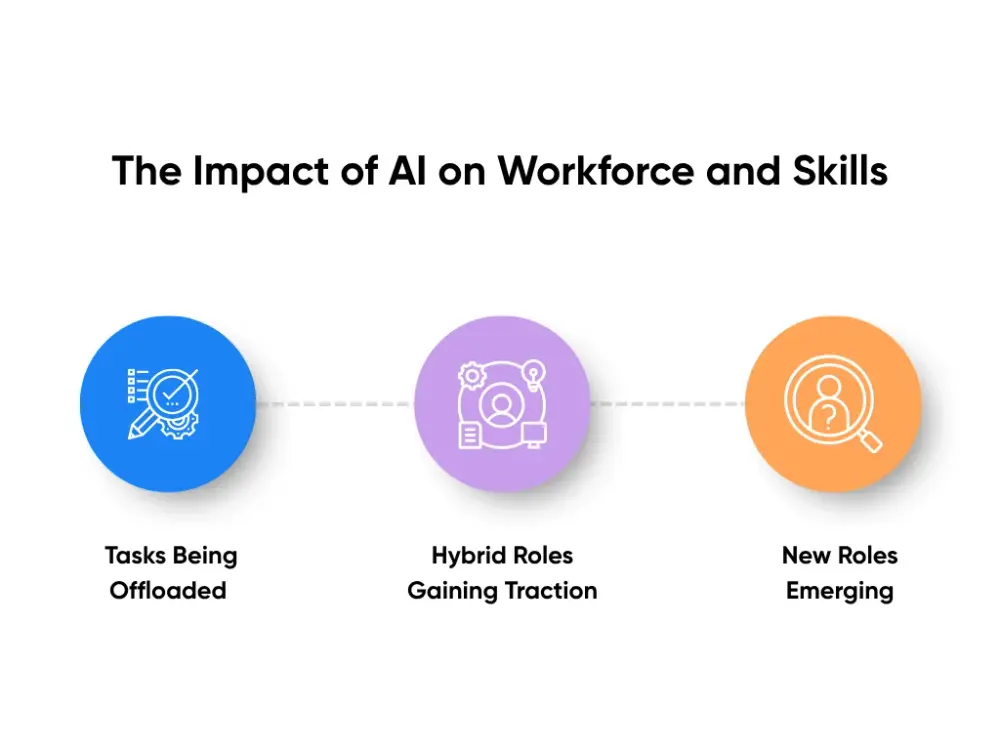
If you're leading transformation, you're probably spending as much time thinking about people as you are about platforms. AI is changing the shape of work, not by wiping out jobs overnight, but by shifting the kinds of tasks that matter.
And that shift is showing up everywhere, from hiring to org charts. For context:
Repetitive Tasks Are Being Phased Out
Customer service teams at large retailers are offloading basic requests, such as order tracking, password resets, return policies, to digital personal assistants that respond instantly. Accounting teams at mid-market firms are using anomaly detection tools to catch mismatched invoices before month-end.
At healthcare providers, intake assistants are using AI to summarize patient data for faster handoffs to physicians. Some of these tools are built on HIPAA-compliant medical transcription engines, like the one Aloa developed for a medical practice, where the AI produces a first pass of a doctor’s dictation with high accuracy on complex medical terminology. This approach speeds up charting and reduces the cognitive load on staff, making it easier to spot critical details before a patient sees the doctor.
Hybrid Roles Are Where Traction Is Building
Orgs aren’t just hiring engineers. They’re looking for translators, like ops leads who can sit between product and dev teams to guide how AI tools plug into daily workflows. Or marketers who know how to prompt-tune content models without waiting on IT.
We’ve seen teams bridge these gaps by building small internal squads. They're pairing domain experts with AI-literate collaborators to run controlled pilots. It's faster than hiring, and it keeps real context in the room while teams learn what works.
AI-Driven Roles Are Emerging, but Slowly
You’re starting to see new jobs emerge around auditability, internal tooling, and compliance review. Enterprise teams in financial services, for example, are building out model oversight groups. At global logistics firms, teams are assigning AI orchestration leads to manage how new tools connect across departments.
But those jobs often show up later, once the systems are live and the risks start getting clearer. Early on, the priority tends to be getting a few things right before scaling people around them.
If you're feeling the pressure to move fast while keeping your team aligned, you're not alone. The orgs making AI work aren't just buying tools. They're rethinking roles, workflows, and how success gets measured. That’s the shift that drives real progress. And we help teams build AI systems around their people, not in spite of them.
Challenges and Risks of AI Adoption
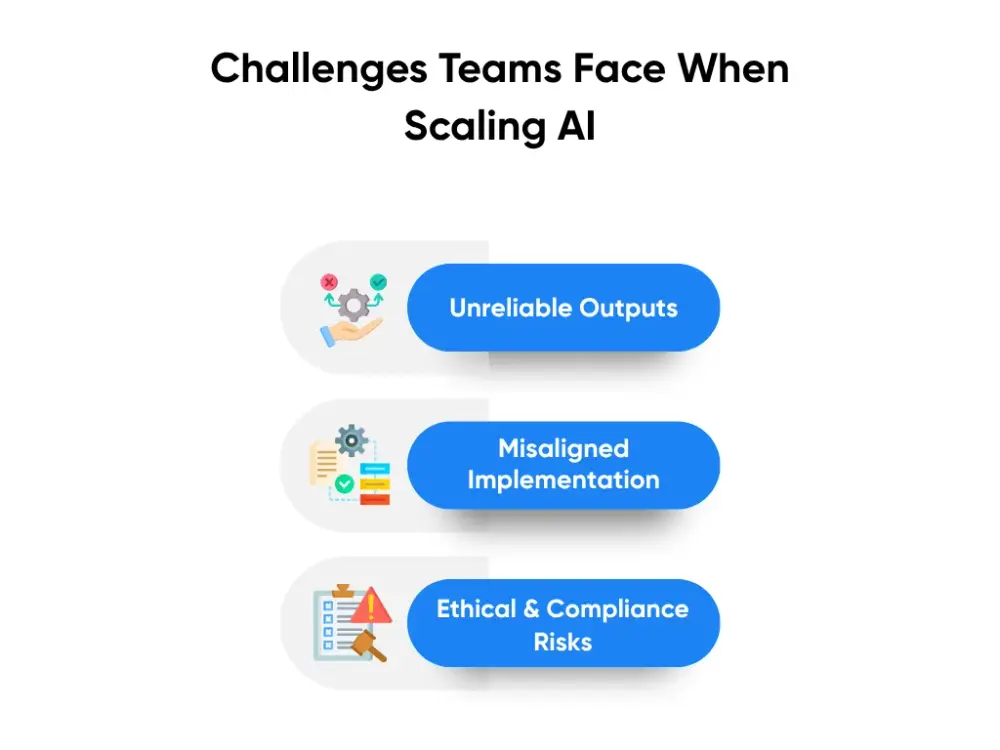
As you're building out AI inside your org, you've likely already run into this: the tools are moving faster than the guidance. And the risks? They show up where you're least expecting them: in team workflows, stakeholder reviews, even customer-facing outputs.
None of these risks are new, but they're becoming harder to ignore:
Unreliable Outputs Are Still Common
We’ve seen teams launch internal copilots only to pull them offline weeks later. Why? Hallucinated data. One director at a financial firm flagged how an LLM-generated report quietly inflated revenue projections. It wasn’t malicious. It was trained on biased, outdated sales templates. But fixing it burned weeks of cleanup.
If outputs aren't audited regularly or the data analysis pipeline is unclear, you're setting up your teams (and execs) for surprises.
Implementation Without Alignment Adds Unnecessary Costs
The tool might be affordable. But everything around it can slow teams down, like retraining workflows, rescoping job responsibilities, or fixing low adoption because the interface doesn’t fit how teams work.
We’ve worked with teams who spent months reworking custom dashboards that were never used, just because stakeholders weren’t involved early enough. It’s not just about budget. It’s about whether your people can actually use what you’re building.
Ethical Compliance Is Becoming a Front-End Issue
Especially if you're working in regulated industries, your AI doesn’t just need to work. It should be legible. Directors in manufacturing and healthcare tell us the same thing: AI tools that can't show their logic don’t survive procurement reviews.
That’s why more teams are testing explainability tools in parallel with deployment. Not because they have to, but because it avoids friction later with auditors, boards, and internal policy teams.
No system is perfect out of the gate. But the teams making AI sustainable? They’re asking hard questions early, about trust, fit, and risk. That’s where partners like Aloa come in.
We help teams prototype responsibly, validate assumptions, and build guardrails that fit how your org works, before the stakes get too high. Aloa builds ethical, scalable AI systems that support real business outcomes.
Future Projections and Investments in AI
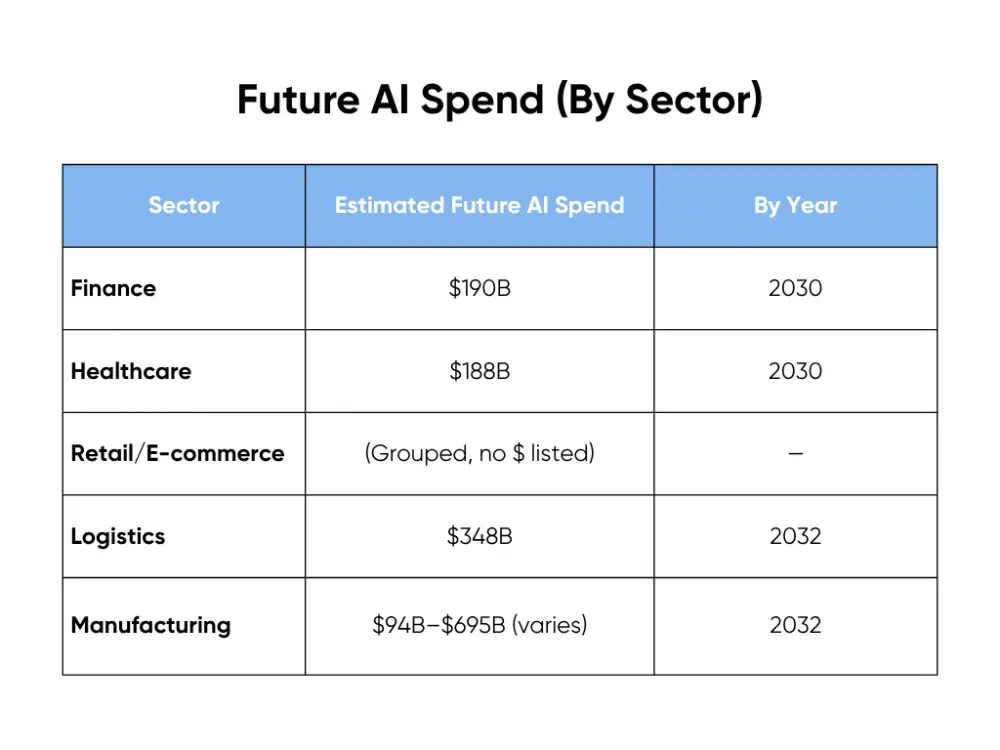
Every org is looking at AI spend right now. Not because it’s trendy, but because the pressure to show real returns is here. And when budget season rolls around, you’re probably being asked: What kind of AI work will actually stick?
Enterprise AI spend is projected to hit $1.8 trillion globally by 2030. But what’s more telling is where that money’s going:
- Finance teams are putting dollars behind tools that reduce risk and speed up reporting. We’re seeing copilots that flag compliance issues, large language models that auto-draft analyst memos, and fraud systems that run in the background. Spend is expected to cross $190B by 2030.
- In healthcare, budgets are leaning into operational support, like tools that generate discharge notes, assist with diagnostics, or streamline intake documentation. Forecasts put global spend here around $188B.
- Retail and e-commerce teams are going after tools that drive margin, like smarter product recommendations, search tuning, and service automation are top of the list.
- In manufacturing and logistics, investment is scaling quickly. AI in logistics is projected to hit $348B by 2032, while manufacturing spend could reach $94B, with some forecasts landing much higher. Most of that’s going into predictive maintenance, demand planning, and real-time routing tools that help ops teams work smarter with what they’ve got. That said, enterprise-grade hardware comes at a steep cost. The NVIDIA H100 GPU price of $25,000-$40,000 per unit pushes many mid-sized companies toward cloud-based AI services rather than building their own infrastructure.
What’s shifting is how leaders are thinking about these tools. Instead of chasing the biggest use case, they’re starting with what’s real. That might be a manual workflow that’s slowing teams down or a dashboard that takes hours to update.
That’s where we work best. At Aloa, we help teams turn those friction points into functional systems: custom copilots, lightweight automations, or internal tools that actually reflect how your people work.
Because the teams making real progress? They’re not just investing in AI. They’re investing in their process.
Key Takeaways
AI adoption in 2025 isn’t about being first. It’s about making decisions that hold up when priorities shift, teams change, and the next wave of tools hits your stack. When you’re looking at how many companies use AI today, it’s clear the ones getting ahead aren’t chasing the flashiest builds. They’re focused on gathering valuable insights early, validating quickly, and scaling deliberately.
If you’re driving transformation, you’ve probably seen how messy things get without a plan. Tools get deployed before teams are ready. Interfaces get built without end users in mind. Progress slows, not because of the tech, but because there’s no roadmap guiding how it fits into the work.
That’s why internal tools have become such a smart starting point. They’re simple systems that help teams find the right data faster, reduce review cycles, or automate tasks that waste hours every week.
We work with teams at this stage, when the goals are clear, the use case is grounded, and the next step is building something real that fits how your business actually operates. Explore Aloa’s AI development services to see how we can support your team in building AI that lasts.
FAQs About AI Integration Trends
1. What percentage of companies use AI in 2025?

Nearly 70% of companies say they’ve adopted at least one AI capability, and that number keeps climbing. This reflects the AI market’s continued expansion and integration into business operations.
The strongest traction is happening where the stakes are high and the workflows are structured: finance, healthcare, retail, and manufacturing.
2. How is AI impacting different industries?
It’s not one-size-fits-all. Banks are using AI to spot fraud and speed up compliance. Retailers are automating inventory decisions and support tickets. Healthcare teams are cutting down intake time with AI summaries. And in manufacturing, predictive maintenance tools are helping avoid costly delays.
Across industries, common AI applications like search engines, predictive models, and digital personal assistants are becoming more common.
3. What are the major challenges in AI adoption?
Hallucinated outputs, clunky interfaces, and compliance headaches. Some tools sound good in demos but fail in daily workflows. Others get shelved because they can’t explain how they work, which is a dealbreaker for regulated teams.
4. Which regions are leading in AI adoption?
The US leads in scaling tools inside large, data-heavy orgs. Europe is slower, but more thorough, especially where data privacy matters. In South America, teams are solving targeted problems with AI that’s easy to test and deploy. And in India, Singapore, and the UAE, national support is helping businesses move fast, especially in logistics, healthcare, and finance.